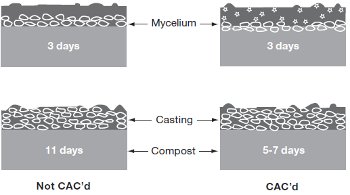CAC or CI
Fully colonized spawn run substrate is used to introduce mycelia into the casing layer. This is often used to improve crop uniformity, crop cycling, mushroom quality, and yields (Figure 14). Spawn run compost at casing (CAC) is used to inoculate the casing during the mixing or application of the casing. CAC is now produced much like spawn — in aseptic conditions — by those who produce and supply spawn to growers. This process is called casing inoculum (CI). By adding the mycelia uniformly throughout the casing, the spawn growth into the casing is quicker and more even. The time from casing to harvest is reduced by 5–7 days so that the rooms can be cycled faster or more breaks can be harvested in the same time. Mycelial growth is uniform on the surface, which encourages the mushrooms to form on the surface as well. Therefore, they are cleaner. Yields are improved since the mushroom growth is uniform and crop management is easier. In addition, more mushrooms are produced from areas that may have less nutrition.

Figure 14. Difference in time when CAC or CI is added to the casing.
The two figures on the left and the two on the right show the difference
in spawn growth over time into the casing.
Managing the crop after casing requires that the compost temperatures until flushing be held at spawngrowing temperatures. After flushing,
compost temperatures are lowered and air temperature becomes the primary control point. Throughout the period following casing, water must be applied intermittently to raise the moisture level to field capacity before the mushroom pins form.
7553 view.